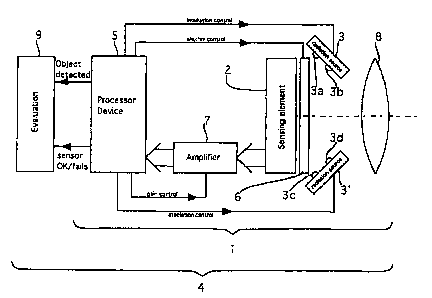Note : Les revendications sont présentées dans la langue officielle dans laquelle elles ont été soumises.
Claims
1. Digital camera comprising an electronic sensing element (2), characterised
by at least one
radiation source (3, 3') which is adapted to irradiate electromagnetic
radiation onto at least part of
the sensing element (2).
2. Digital camera as claimed in claim 1, characterised in that the digital
camera (1) is part of a
motion sensor device (4).
3. Digital camera as claimed in claim 1 or 2, characterised in that, the
digital camera (1) is a
video camera.
4. Digital camera as claimed in anyone of claims 1 to 3, characterised in that
the digital camera
(1) comprises at least one processor device (5).
5. Digital camera as claimed in claim 4, characterised in that the processor
device (5) includes a
microprocessor.
6. Digital camera as claimed in claim 4 or 5, characterised in that the
processor device (5) is
adapted to control the radiation source (3, 3') to send out radiation onto at
least part of the
sensing element (2).
7. Digital camera as claimed in anyone of claims 4 to 6, characterised in that
the processor
device (5) is adapted to read out signals from the sensing element (2) and is
further adapted to
analyse whether the read out signals correspond correctly to the
electromagnetic radiation which
is irradiated onto the sensing element (2) by the radiation source (3, 3').
8. Digital camera as claimed in anyone of claims 1 to 7, characterised in that
the radiation source
(3) comprises more than one radiation element (3a, 3b, 3c, 3d), wherein each
of the radiation
elements (3a, 3b, 3c, 3d) is directed to different parts of the sensing
element (2).
6
9. Digital camera as claimed in claim 8, characterised in that at least some
of the radiation
elements (3a, 3b, 3c, 3d) emit radiation of different wavelengths.
10. Digital camera as claimed in anyone of claims 1 to 9, characterised in
that the digital camera
(1) comprises a shutter (6) which is adapted to apply radiation onto the
sensing element for a
given time interval.
11. Digital camera as claimed in claim 10, characterised in that the processor
device (5) is further
adapted to analyse whether the read out signals correspond correctly to the
given time interval.
12. Digital camera as claimed in anyone of claims 1 to 11, characterised in
that the digital
camera (1) is provided with a variable gain amplifier (7), wherein the
processor device (5) is
adapted to control the gain factor of the amplifier and is further adapted to
analyse whether the
read out signals correspond correctly to the selected gain factor.
13. Method for testing the function of a digital camera (1), having a sensing
element (2),
particularly a video camera which is part of a sensor device (4),
characterised by the step of
irradiating electromagnetic radiation onto at least part of the sensing
element (2).
14. Method for testing the function of a digital camera (1) as claimed in
claim 13, characterised
by the step of reading out signals from the sensing element (2) and the step
of analysing whether
the read out signals correspond correctly to the electromagnetic radiation
which is irradiated onto
the sensing element (2).
15. Method as claimed in claims 13 or 14, characterised by the step of sending
out radiation
predominantly onto a selected part of the sensing element (2).
16. Method as claimed in claim 15, characterised by the step of sending out
radiation from an
edge of the sensing element (2).
7
17. Method as claimed in anyone of claims 13 to 16, characterised by the step
of sending out
radiation onto the sensing element (2) with an on/off-modulation.
18. Method as claimed in anyone of claims 13 to 17, characterised by the step
of sending out
radiation onto the sensing element (2) with a characteristic variation of the
irradiation intensity
over the sensing element (2).
19. Method as claimed in anyone of claims 13 to 18, characterised by the step
of providing a
shutter (6) for applying radiation onto the sensing element (2) for a given
time interval and by
the step of analysing whether the read out signals correspond correctly to the
given time interval.
20. Method as claimed in anyone of claims 13 to 19, characterised by the steps
of:
a) providing the digital camera (1) with a variable gain amplifier (7);
b) controlling the gain factor of the amplifier and
c) analysing whether the read out signals correspond correctly to the selected
gain factor.
21. Method as claimed in anyone of claims 13 to 20, characterised by the steps
of:
a) irradiating the sensing element (2) with electromagnetic radiation varying
in wavelength as a
function of time;
b) analysing whether the read out signals correspond correctly to the
wavelength of the applied
radiation.
8
